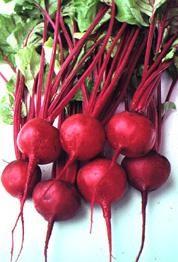Beets: How to grow and harvest
-
Beets are annuals that grow about 18 inches tall. They are easy to grow, and almost the whole plant is edible. The roots, of course, are the primary vegetable, but beet greens have long been valued in the south as a "pot vegetable," usually cooked with a bit of bacon or salt pork. Beets are rich in fiber, potassium, iron, and folate. The compound that gives beets their rich, crimson color -- betacyanin-- is also now believed to be a serious tumor-fighting agent.
Cultivation and harvesting
Beets can be sown or planted in Marin County throughout most of the spring and summer, with September the last chance before winter. Those planted in July and August will be ready for harvest through October -- most varieties will mature within 55 to 70 days.
Beets prefer loose, well-drained soils but will tolerate a wide range. In high-clay soils, adding compost or other organic matter helps improve soil structure. Beets are sensitive to soil acidity -- they prefer a pH of 6.2 to 6.8 but will tolerate 6.0 to 7.5. A low soil pH results in stunted growth. Beets make a fine raised-bed crop since soils are generally looser and less compacted.
When planting beets from seed, sow the seeds 1/2-inch deep and about one inch apart. Rows should be 12 to 18 inches or more apart. When the seedlings are one to two inches tall, thin to about one plant per inch. As they grow, thin to about three to four inches between plants. (Tip: you can cook and eat the “thinnings” -- these small leaves are especially tender and flavorful.) Succession planting can be made at three-week intervals throughout the season. As with any plant, avoid seeding during hot daytime temperatures. It is best to cover the rows with floating row covers immediately after planting to deter leafhoppers, leaf miners, and other pests. Give plants regular water but avoid over-watering, and mulch after plants are established.
Beet roots can be harvested early, as baby beets, or when more fully mature, but are really best small, at 1 to 2 inches in diameter. To harvest, simply pull the entire plant up.Beet varieties:
- Chioggia (55 days) is a sweet, slightly peppery Italian heirloom with beautiful concentric circles of red and white flesh.
- Golden beets (55 days) are a deep gold color and taste "beety," but are not quite as intensely red and earthy as red varieties.
- Bulls Blood (55 days) is an heirloom beet with a nice earthy yet sweet flavor. The leaves are a stunning red color, as is the beet itself, a bit darker and richer than usual. (This beet was listed pre-1900 in England. It may be the only decorative-leafed Victorian beetroot variety surviving.)
- Detroit Dark Red (60 days) is a well-liked deep-red variety that grows 2 to 3 inches in diameter.
- Red Ace (50 days) are very sweet, with slight color variation in concentric rings.
- Early Wonder (55 days) are small-medium in size, sweet, tender, and purplish-red in color.
Beetroots can be boiled, steamed, or roasted after being trimmed. They are easiest to peel if boiled or steamed, but roasting concentrates the flavor and provides a more intense "beetiness."
Beet greens can be steamed or sautéed until tender. Avoid overcooking as they turn a bit brownish and are less fresh tasting.
Bon appetit!
Original article by UC Sonoma Master Gardener Steven Hightower
Edited for the Leaflet by Jane Scurich

